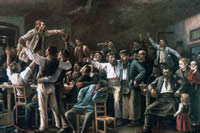Lesson Four: Responses to the Conditions Created by Classical Liberalism
3. Lesson Part 3.4.2: Improving Conditions for the Working Class
The Industrial Revolution was the beginning of our modern age and introduced the technological benefits so widely enjoyed today. However, the workers in the early days of industrial development in England were exploited by the factory owners. Wages were very low, cities were crowded, violent, and dirty, and coal dust was everywhere because coal was used to power steam engines (no electrical or gasoline engines yet). Workers were often sick, and disease was rampant from lack of sanitation. There was no garbage pick up, and doctors were expensive. Workers, including women and children, were forced to work long hours with little concern for their health or safety.
In Great Britain until 1802, no laws protected workers against dangerous working conditions, long working hours, and the use of children as labourers. Britain, as well as other European countries, was a society based on the laissez-faire economics of classical liberalism. If people were willing to work under those conditions, the government should not get involved.
However, the workers were not willing to work under such conditions. They had no choice, but from time to time, the workers expressed their dissatisfaction by protesting against the factory owners. In the early years of the Industrial Revolution, little progress was made by labourers in improving working conditions. The government did not allow workers to organize into labour unions because giving the workers more rights would reduce profits for the rich factory owners. At that time, the rich landowners controlled government.
Several groups or movements formed during the Industrial Revolution to attempt to improve the living and working conditions of the working classes. These groups began to push society and governments to enact laws to better the lives of factory workers. In addition to workers, members of these groups often included some entrepreneurs, such as Robert Owen, who already treated their workers better and wished to promote human rights everywhere. Celebrities of the time were often members of such groups, too.
Even John Stuart Mill began to change some of his classical liberal ideas. He stated in his writings:
"To achieve their greatest potential, individuals should do as much as possible for themselves."
This was similar to what Adam Smith had taught. Mill's views began to change, however, as he observed the worsening conditions of life and work that degraded industrial workers. He saw that government needed to take a larger hand in the economy.
Mill came to advocate that government must take action to correct the abuses of capitalism. He believed capitalism could be improved but did not suggest getting rid of it.
Robert Owen was a successful textile manufacturer who believed people would work better if they lived in healthy environments. At his own expense, Owen built a factory community in Scotland in 1800. He paid his workers well while providing good housing and schools. To combat high cost of living expenses, Owen established stores where goods could be bought cheaply.
Owens' factory community was a success for his workers, and it was profitable. Watch this brief video to learn a little bit more about Robert Owen and his ideas.
The British Factory Acts were examples of government changes introduced because of demands by workers. Employees were no longer willing to work under the same harsh conditions. Many Factory Acts were introduced to protect the workers-especially the children.

Workers Strike
The Factory Acts also encouraged all workers to unite and demand better working conditions for themselves. A group of workers can form and represent the will of the workers. Organized labour unions can represent better the needs of the workers. The workers are able to continue working while the labour union negotiates better working conditions and salaries.
In the 1870s, labour unions were recognized and tolerated in Great Britain. At that time, all workers obtained a ten-hour workday, the right to strike, and the right to vote. The labour force was established. The Industrial Revolution led to labour laws being introduced in the Factory Acts. This opened the door to the study and the evaluation of classical liberalism.
Later during the 1800s, voting rights were given to more people than just the rich landowners. Liberal democracies came into being across Europe, which tended to protect the individual and collective rights of all their citizens, not just the rich. Classical liberal beliefs and values changed slowly, and during the late 1800s, government social programs such as public education and providing for the poor began to emerge. Those that promoted classical liberalism opposed such welfare states , but modern liberalism was evolving from the necessity for more equality and better living and working conditions for the common good. That is, not just the rich but the workers as well were beginning to have some benefits.
Classical liberalism evolved into modern liberalism with changes, mostly through government intervention, in the following areas:
-
Labour Standards: Laws, such as the Factory Acts, improved working conditions providing fewer hours of work, safer and healthier workplaces, and decrease in child labour.
-
Unions: Organizations of workers to improve working conditions and wages were allowed.
-
Voting Rights: Suffrage (voting rights) was expanded to include men who did not own property.
-
Protection of of Human Rights: Human rights guarantees were expanded eventually to include all citizens, regardless of race.
-
Feminism: Through the determination of many female leaders, women fought hard to obtain equality with men, including the right to vote and protection of human rights.
-
The Welfare State: Governments developed social welfare programs such as unemployment insurance, old-age pensions, universal health care, and public education.